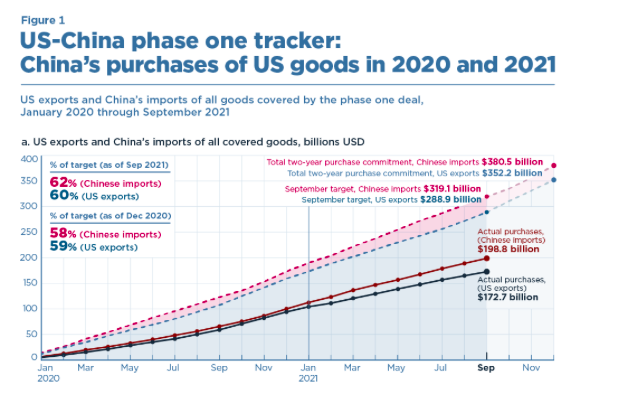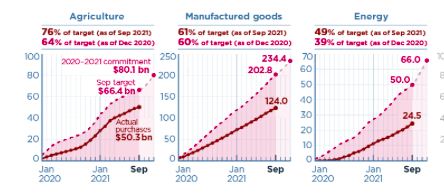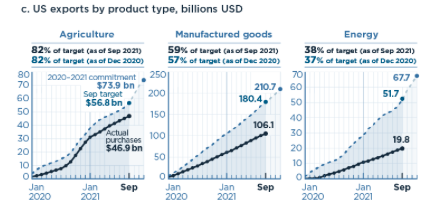2021 Corn Exports to China Set To Crush Expected Target By 1,000%, Phase One Finale In Focus
U.S. Farm Report 11/13/21 - Roundtable 1
USDA’s latest crop projections threw a bit of a shock into the soybean market. The November Crop Production Report came with change to both projected soybean and corn yields, as well as production.
According to USDA, U.S. farmers are expected to produce 15.1 billion bushels of corn this year, which is a 43-million bushel boost from October. That’s based on a national average yield that’s expected to set a new record of 177 bu. per acre. Considering the drought that plagued production in states like North Dakota, South Dakota and Minnesota, Ohio State University ag economist Seungki Lee says the yields are a testament to crop genetics at work in fields today.
“The overall production outcome is quite large still,” says Lee. “The corn production is over 15 billion bushels, which is a record high and the nationwide corn average corn is also record high at about 177 bushels per acre.”
The soybean crop projection was cut 23 million bushels due to lower yields. USDA projects the national soybean yield to hit 51.2 bu. per acre, a slight reduction from the October report. And while USDA’s reduction did fuel the soybean market, he says soybean yields also showed resilience in the midst of drought.
“Overall, apparently farmers did pretty well this year, even though they had gone through pretty tough weather challenges this year,” he adds.
China and U.S. Relations in the Spotlight
Monday, President Biden and China’s Xi Jinping are scheduled to meet, with the White House saying the two countries will hold a virtual summit. Prior to Monday’s meeting, the White House seemed to try to set low expectations for the video call between the leaders, with the White House saying no major announcement is expected.
The talks are occurring as the Phase One trade agreement between the two major world economic powerhouses is also coming to a close. The commitments made by China officially started in January 2020 and run through December 31, 2021. Ohio State’s Ian Sheldon focuses on policy and trade. He says while China isn’t buying at the same pace of last year, it’s important to note that China is still the top buyer for U.S. agriculture.
“China is still forecast to be our largest export market this year,” Sheldon told U.S. Farm Report. “So, the ranking is China, Canada, and then Mexico, which is exactly what you'd expect here in North America with the U.S. Mexico Canada Agreement (USMCA) and just the fact that we're close by geographically. But China is forecast to be our largest export market.”
Ag Commitments in Phase One Deal
While soybean sales have created doubts on just how much China will end up sourcing over the next year, Sheldon says to date, overall agricultural exports destined for China look to miss the mark. But there are bright spots in the overall story.
"In terms of agricultural exports, it looks like for 2021, we're going to hit about 84% of the commitments that China made to import. So, a lot of that is going to be dependent as we go out through the end of the marketing year, and particularly how much corn and soybeans are exported to China.”
However, it's commodities like corn, cotton, wheat and cotton that seem to be driving the boost in China's appetite in 2021.
“If you look at exports to China across commodities, soybeans are not hitting the target that they were expected to hit. Then, corn is way over target, we're talking about 1,000% higher than where it was expected to be, along with our pork exports that have been very strong to China, as well as our wheat exports and our cotton exports. So, you have to sort of look at it in the aggregate and by commodities, as well.”
Phase One Grade Overall
How does China stack up overall in terms of its commitments under the Phase One agreement? PIIE produces a chart that tracks China's monthly purchases of U.S. goods covered by the deal. It says the information relies on data from both Chinese customs (China's imports) and the U.S. Census Bureau (U.S. exports), and then compares that against the legal annual commitments made by China under Phase One. According to PIIE, as of September 2021, China's purchases of all covered products reached 62% of Chinese imports, or 60% of the U.S. export targets.



Demand in Doubt
The reduction in soybeans seemed to be the fuel prices needed to recover some of the price losses the soybean market produced leading into the report. And while the production picture didn’t grow, the demand for soybeans doesn’t seem to be growing, at least not from China.
“At this moment, it is hard to imagine that China will buy the same amount as last year,” Lee told U.S. Farm Report. “For instance, of soybean exports, it’s actually down about 33% compared to last year. And as their domestic demand has changed, at the moment, it’s hard to imagine a big shift can change immediately from now on.”
Lee cautions that the unexpected is always a possibility, and used African Swine Fever (ASF) in China as an example. As China worked to rebuild their herd, the appetite for feed grew, which was a major factor in the U.S. exporting a record amount of ag products last year.







